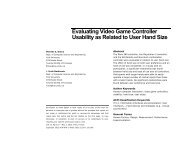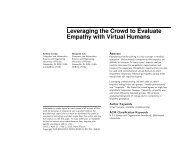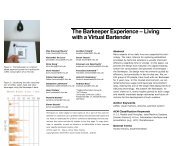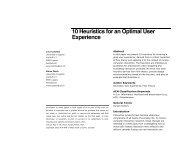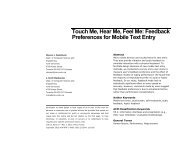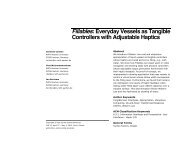Neurodiversity & HCI - alt.chi 2013
Neurodiversity & HCI - alt.chi 2013
Neurodiversity & HCI - alt.chi 2013
Create successful ePaper yourself
Turn your PDF publications into a flip-book with our unique Google optimized e-Paper software.
• Identified learning-disabled students who are<br />
also gifted- when the burden of learning<br />
disabilities outweighs the gifts, these<br />
individuals fall into the category of learning<br />
disabled students.<br />
• Unidentified students- these are students who<br />
have a heavier burden of learning disabilities<br />
but also gifts, by using their talents to<br />
overcome their weaknesses they result in<br />
appearing only ‘average’ to their<br />
contemporaries. Their gifted qualities may go<br />
unnoticed. This adaptation mechanism can be<br />
so effective that individuals may not<br />
themselves be aware of having a condition and<br />
may only be identified much later in life. For<br />
example, some successful adults with ADHD<br />
are only identified when their <strong>chi</strong>ldren are<br />
diagnosed.<br />
As such, we can see some aspects of high functioning<br />
abilities in relation to what is typically seen as<br />
disability. This situation can be more clearly explained<br />
in figure 1. Here we consider two axes. The first vertical<br />
axis is that of degree of ability. While degree of<br />
cognitive function is both subjective and, as we argued,<br />
also bound by socially enforced norms, the axis relates<br />
to our everyday notion of cognitive ability. The<br />
horizontal axis is the severity of condition. Again, this<br />
synthetically combines both positive and negative<br />
aspects of a particular condition. For example, we<br />
might begin on the left with Asperger’s and the move to<br />
autism on the right. The curve consists of a number of<br />
individuals conceptually plotted along the scattergram.<br />
It begins in the middle with what would be regarded as<br />
neurotypical. As the cognitive condition (dyslexia,<br />
Asperger’s, ADHD) increases minor problems occur but<br />
are outweighed by the benefits. At the peek this zone<br />
comprises people that Baum identifies as ‘Identified<br />
gifted students who have subtle learning disabilities’. As<br />
the curve reaches its zenith, we enter the talented<br />
zone, and we see the people we would regard as truly<br />
gifted. Einstein is held up as an icon for dyslexics, but<br />
he was never tested during his life. As problems<br />
increase, we enter the zone where the negatives<br />
outweigh the positives. It in this zone close to the<br />
‘normal’ line we find Baum’s ‘Unidentified students’.<br />
These are people who appear normal but have to<br />
devote a huge amount of their gifts to cope or manage<br />
the downsides. As mentioned many people who are so<br />
adept at coping and in doing so appear as<br />
unexceptional can discover a cognitive problem later in<br />
life are likely to appear in this area. Finally, when the<br />
negatives outweigh the positives, we get the severe<br />
end of any condition. Occasionally we see gifts as seen<br />
in savants for instance, the ability to multiply 20 digit<br />
numbers yet are unable to tie a shoelace.<br />
So, we have seen that neurodiversity consists of three<br />
pillars. Upsides and the spectrum help to explain that<br />
these conditions are not one-off defects or aberrations<br />
but a reflection of the larger diversity of humanity.<br />
Case studies of the <strong>Neurodiversity</strong><br />
Perspective for <strong>HCI</strong><br />
The paper will now use the view of neurodiversity to<br />
reflect upon a number of case studies which will<br />
demonstrate how the neurodiversity perspective is<br />
relevant to <strong>HCI</strong>.



